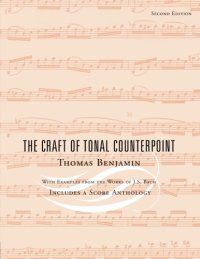
Ebook: The Craft of Tonal Counterpoint
Author: Thomas Benjamin
- Genre: Art // Music
- Tags: #Counterpoint, #Tonal Counterpoint, >> #Musical Counterpoint, #Thomas Benjamin, #The Craft of Tonal Counterpoint, #Chamber Music, #Classical, #Musical Genres, #Music, #Arts & Photography, #Reference, #Music, #Arts & Photography, #Composition, #Theory Composition & Performance, #Music, #Classical, #Composers & Musicians, #Arts & Literature, #Biographies & Memoirs, #History and Criticism
- Year: 2003
- Publisher: Routledge
- Edition: 1
- Language: English
- mobi
The Craft of Tonal Counterpoint is an introductory text to the analysis and composition of tonal counterpoint. Tonal counterpoint is the basis of all classical music composition; students of music theory and composition are all required to take a course on this topic. Using examples from the music of J.S. Bach - the master of this style - the author takes students through a series of carefully graded, cumulative exercises that stress both analysis and writing. Benjamin covers chromaticism and fugal writing in exceptional detail. The exercises cover a wide range of formats, including error detection, linear pitch reduction, analysis and composition. The book also incorporates a 100-page anthology of scores, effective for analysis, in-class performance, and compositional models.
Excerpt
In the roughly seventeen years since the first edition of this book appeared, a great deal has changed in the field of music theory, and several intelligent and interesting new textbooks for the study of tonal counterpoint have appeared. At the same time, the continuing popularity of this text, as well as the need to update its explanations and exercises, has encouraged the author to undertake a revision.
My original reasons for writing this book still seem valid. Of the several other texts in this field currently available, all seem, while in many ways estimable, problematic as regards their pedagogy. Some strike me as insufficient in the ordering, rigor, or comprehensiveness of their exercises; crucial conceptual or skills-developing steps may be omitted. Other texts seem unfocused and diffuse in terms of musical style: works by vastly disparate composers are thrown together in a way that seems likely to confuse the student. Still others appear to be aimed at the already expert theorist of music, and are so tied to specific metatheoretical concepts and language that many students will be sure to find them mystifying.
The danger of such approaches is to complicate technical and stylistic matters by wrapping them in theoretical constructs, reinforcing the tendency of most music students to assume that “music theory” is an abstruse and mystical discipline divorced from their own experience of music-in other words, that “music theory” is an undertaking entirely separate from musical practice, and from their own lives and needs as practicing musicians.
The attempt in the current edition is to construct a book that the intelligent student can read and understand, with some help from the instructor. It focuses on the work of Johann Sebastian Bach, and aims to be practical and useful as a study of both style and technique through performance, listening, analysis, and writing. It reflects current thinking about tonal music in its emphasis on structural harmony and line, structural-pitch reduction, linear-intervallic patterning, and so on, but presents these concepts in what I hope is a practical and immediately applicable way, as free as possible from abstract theorizing, and always focused on the music itself.
Those students and instructors who wish more background information on Bach's life and output and other issues of music history, theory, and literature are referred throughout the text to appropriate resources.
Excerpt
In the roughly seventeen years since the first edition of this book appeared, a great deal has changed in the field of music theory, and several intelligent and interesting new textbooks for the study of tonal counterpoint have appeared. At the same time, the continuing popularity of this text, as well as the need to update its explanations and exercises, has encouraged the author to undertake a revision.
My original reasons for writing this book still seem valid. Of the several other texts in this field currently available, all seem, while in many ways estimable, problematic as regards their pedagogy. Some strike me as insufficient in the ordering, rigor, or comprehensiveness of their exercises; crucial conceptual or skills-developing steps may be omitted. Other texts seem unfocused and diffuse in terms of musical style: works by vastly disparate composers are thrown together in a way that seems likely to confuse the student. Still others appear to be aimed at the already expert theorist of music, and are so tied to specific metatheoretical concepts and language that many students will be sure to find them mystifying.
The danger of such approaches is to complicate technical and stylistic matters by wrapping them in theoretical constructs, reinforcing the tendency of most music students to assume that “music theory” is an abstruse and mystical discipline divorced from their own experience of music-in other words, that “music theory” is an undertaking entirely separate from musical practice, and from their own lives and needs as practicing musicians.
The attempt in the current edition is to construct a book that the intelligent student can read and understand, with some help from the instructor. It focuses on the work of Johann Sebastian Bach, and aims to be practical and useful as a study of both style and technique through performance, listening, analysis, and writing. It reflects current thinking about tonal music in its emphasis on structural harmony and line, structural-pitch reduction, linear-intervallic patterning, and so on, but presents these concepts in what I hope is a practical and immediately applicable way, as free as possible from abstract theorizing, and always focused on the music itself.
Those students and instructors who wish more background information on Bach's life and output and other issues of music history, theory, and literature are referred throughout the text to appropriate resources.
Download the book The Craft of Tonal Counterpoint for free or read online
Continue reading on any device:

Last viewed books
Related books
{related-news}
Comments (0)